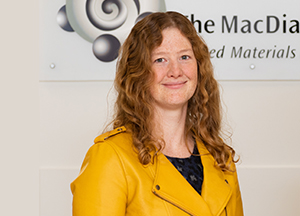
Nicola Gaston, MacDiarmid Institute
The manipulation of interatomic interactions for structural self-assembly is a seductive promise of nanotechnology, most tantalisingly made evident by biological examples in nature. Much of the promise of sustainability in materials science comes from the idea of such structural control being able to be achieved at low energetic cost.
At the risk of anthropomorphising atoms, this talk will present some examples of how, by developing an understanding of how particular atoms want to behave, we can manipulate structure by proxy. Not through forcible manipulation of atoms, but through understanding their environmental preferences, and how these change through many-body interactions as they assemble.
The use of low-temperature liquid metals, such as gallium, as media for the dilution of other metals has led to an increasing variety of examples of how temperature- and concentration-dependent interactions can be used to direct the self-assembly of nanostructure, with astonishing precision, resulting in novel pattern formation [1]. This talk will introduce the use of ab initio molecular dynamics for the elucidation of the mechanisms of structural formation, whether via the differential mobility of dopant metal atoms [2], or due to the formation of structure at the surface of the liquid metal [3]. The concentration-dependence of the alloy behaviour will also be discussed [4].
Finally, the mechanism of nanocrystal formation within liquid metals will be discussed, based on ab initio calculations [5], giving insight into the atomistic self-assembly process.
- Tang, J., Lambie, S., Meftahi, N., Christofferson, A., Yang, J., Ghasemian, M., Han, J., Allioux, F., Rahim, A., Mayyas, M., Daeneke, T., McConville, C., Steenbergen, K., Kaner, R., Russo, S., Gaston, N., Kalantar-Zadeh, K., Unique surface patterns emerging during solidification of liquid metal alloys. Nat. Nanotech. 16, 431—439, (2021).
- S. Lambie, K. G. Steenbergen & N. Gaston, A mechanistic understanding of surface Bi enrichment in dilute GaBi systems. Phys. Chem. Chem. Phys. 23, 14383—14390, (2021).
- J. Tang, S. Lambie, N. Meftahi, A. J. Christofferson, J. Yang, J. Han, Md. A. Rahim, M. Mayyas, M. B. Ghasemian, F.-M. Allioux, Z. Cao, T. Daeneke, C. F. McConville, K. G. Steenbergen, R. B. Kaner, S. P. Russo, N. Gaston, and K. Kalantar-Zadeh, Oscillatory bifurcation patterns initiated by seeded surface solidification of liquid metals. Nature Synthesis, 1, 158—169. (2022).
- S. Lambie, K. G. Steenbergen, & N. Gaston, Concentration dependent alloying behaviour of liquid GaAu. Chem. Comm., 58, 13771—13774, (2022).
- S. A. Idrus-Saidi, J. Tang, S. Lambie, J. Han, M. Mayyas, M. B. Ghasemian, F.-M. Allioux, S. Cai, P. Koshy, P. Mostaghimi, K. G. Steenbergen, A. S. Barnard, T. Daeneke, N. Gaston, K. Kalantar-Zadeh, Liquid metal synthesis solvents for metallic crystals, Science, 378, 1118—1124, (2022).
About the presenter
Prof Nicola Gaston studies variations in physical properties of materials as a function of size, from few-atom clusters to large nanoparticles and the bulk at the University of Auckland. Her research seeks an understanding of the relationship between electronic structure, physical properties effects of the underlying material structure. Nicola is a prominent science communicator and advocate for women in academia, a past President of the New Zealand Association of Scientists, and author of Why Science Is Sexist.
